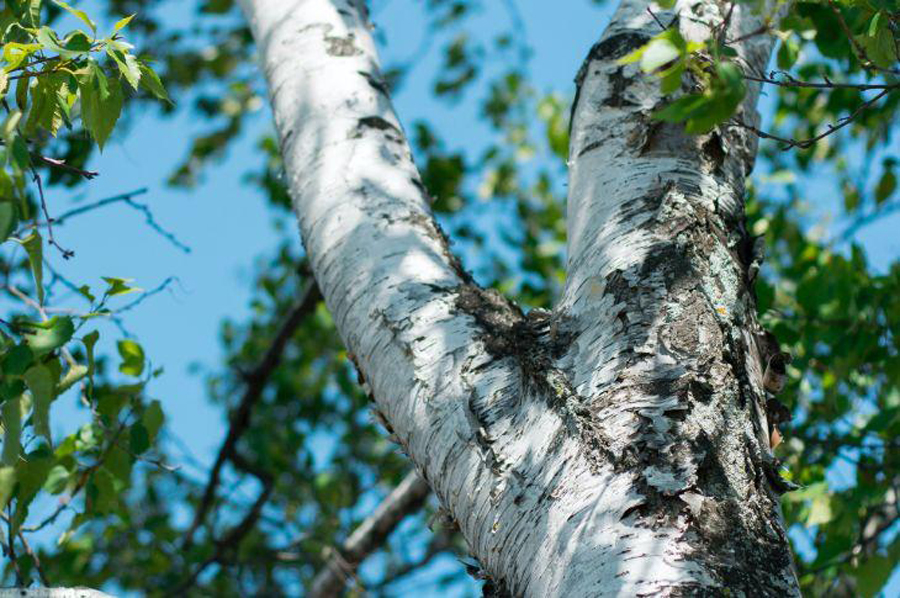The bark of the white birch tree has been used as a folk medicine and natural remedy for thousands of years. Traditionally, birch bark extract was created by steeping birch bark in either alcohol or fat, with the resulting product then being used to heal wounds and skin conditions, as well as preventing bacterial and fungal infections.

Today, scientists have discovered that not only were our ancestors on to a good thing with their birch bark skin creams and salves, but that the powerful “triterpenes” contained within birch bark also have extremely potent anti-cancer and anti-inflammatory effects too.
The Birch tree is a tall, conical to spreading, deciduous tree with glossy, mid to dark green, diamond shaped leaves. It has shaggy, red brown bark that peels in layers on young trees: on older specimens, the bark becomes blackish or gray-white and develops cracks. Yellow-brown male catkins are conspicuous in spring. Makes a fine specimen tree, but only for a large garden.
There three commonest species of birch are the Gray (Betula popuhfoha) , Yellow and Black, flowering in succession and with their periods overlapping. The paper birch occurs naturally in the northern part of New England and Pennsylvania, and it and the European white birch are frequently planted in city parks and streets. The birches rank perhaps second to the oaks m importance, and the cases of hay fever from their pollen which have been recorded appear to be very severe.
Birch adds something to the landscape that no other tree has powder-white bark with black markings. The bark sloughs off throughout the year, adding even more interest to the tree. Birch is deciduous, but even in the winter with the leaves gone, it is an attractive tree. The small twigs are a reddish-brown, contrasting with the white bark. Place some evergreens under Birches and you have a great picture in winter. The twigs of the European White Birch are pendulous and hang gracefully to the ground. The leaves are somewhat heart-shaped, 1.5 inches long, and about as wide. They are light green and turn yellow very late in the fall; its spring flowers are pendulous catkins 1 to 2 inches long. The persistent fruit looks just like the catkin and contains thousands of seeds that attract lots of birds to feed all winter long.
What are Triterpenes?
Birch bark contains possibly hundreds of beneficial chemical compounds, but the main components found in abundance are betulin and betulinic acid derivatives.
Betulin and betulinic acid are both classified as “triterpenes”. These are a category of chemical compounds that are made up of three smaller terpene units, commonly found in animals, plants and certain varieties of fungi. One of the most important triterpenes made by most of the plant and animal kingdom is “squalene”, a precursor to all steroids.
As well as being found in birch bark, triterpenes can be found in all manner of plants, roots and seeds, and are responsible for common scents like lavender, orange peel and thyme.
Betulin
First isolated in 1788, betulin is found abundantly in hundreds of species of plant, but one of the richest sources is birch bark, whose white colouring is actually caused by the presence of betulin, where it is used by the birch tree to protect itself from the low-angled winter sun.
Despite being found in birch bark in abundance, betulin and betulinic acid solubility is very low, so it hasn’t been extracted in large quantities until relatively modern times.
The Extraction Procedure:
Betulin is isolated from birch bark extract using solvents like acetone, ethanol and chloroform. Sometimes superheated steam and hydrogen peroxide are also used to extract the compounds from the bark. Depending on species, modern processing can yield upwards of 70-80% of betulin derivatives, and although overall solubility is poor, the many derivatives of betulin, like betulinic acid, are easily produced, and extremely useful for scientific research.
What is Betulinic Acid?
Betulinic acid is another triterpene, and is derived from betulin itself. Betulinic acid production takes place via betulin oxidation, and betulinic acid has been known to science for at least 100 years. However, until a group of scientists at the University of Illinois drew attention to its potential in a study in 1995, relatively little was known about the substance.
A Range of Potential Uses
Betulinic acid clinical trials have been conducted on a wide range of diseases and conditions, and show promising properties that could help to combat HIV, many different types of cancer, and various types of general inflammation.
Betulinic acid supplements have also shown promise in tackling type II diabetes, fungal infections and even viruses, so there’s a huge amount of research still to be done in order to find out just what this miraculous substance is capable of.
Anti-Cancer Potential
Betulinic acid has been widely studied as an anti-cancer drug, and although the exact mechanism of how it inhibits tumour growth is still under inverstigation, the results are nevertheless promising, with the compound seeming to trigger the mitochondrial pathways associated with apoptosis, or cell death of the tumour tissues.
Research has so far shown betulinic acid benefits on a range of cancers, from lymphomas to skin, lung, bowel and intestinal.
HIV Treatments
Because betulinic acid reduces overall bodily inflammation and can even help to fight viruses, a great deal of research has also taken place on the compound’s use as an HIV treatment. Although studies are still ongoing, the positive effects of betulin derivatives on HIV are promising.
In Conclusion
Betulin and betulinic acid have been studied extensively over the last 25 years, and the results are beginning to look more and more interesting: These naturally occurring plant extracts are showing excellent potential in the fight against cancer, and can even help to tackle the growing epidemic of obesity and diabetes, whilst at the same time healing wounds and reducing inflammation. The extracts of the birch tree really do seem to be a natural wonder supplement!

